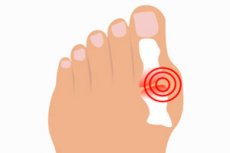
一项新的研究发现,给糖尿病前期患者服用二甲双胍也能降低患痛风的风险。
根据波士顿布莱根妇女医院的医学博士 Javier Marrugo 及其同事提供的数据,在 1,154 名糖化血红蛋白 (HbA1c) 水平升高(略低于2 型糖尿病的阈值)并开始服用二甲双胍的患者中,在为期 4 年的中位随访期间,痛风的诊断率为每 1,000 人年 7.1 人(95% CI 5.1-10.0)。
研究人员在《风湿病年鉴》杂志上报告称,在未开始服用二甲双胍的近 14,000 名类似患者中,痛风的发病率为每 1,000 人年 9.5 人(95% CI 8.8-10.2),使用二甲双胍的相对风险为 0.68(95% CI 0.48-0.96)。
然而有趣的是,二甲双胍似乎对血清尿酸或C 反应蛋白(CRP) 水平没有影响,这使得结果的解释变得复杂。
这并不是第一项发现抗糖尿病药物与痛风风险降低之间存在联系的研究。此前,格列净(gliflozin)等药物也发现了这种联系,这种药物会增加尿液中葡萄糖的排泄,但尿酸水平会降低。
二甲双胍当然是2型糖尿病最常见的一线治疗药物,其相对安全性使其成为糖尿病前期(本研究中定义为糖化血红蛋白(HbA1c)5.7%-6.4%)患者的首选药物。Marrugo及其同事指出,许多关于二甲双胍的研究都证实了其抗炎作用。“因此,除了其在降低糖尿病风险方面的既定作用外,二甲双胍还可能与降低糖尿病前期患者的痛风风险相关,”他们解释说。
在当前的研究中,Marrugo 的团队分析了 2007 年至 2022 年间在麻省总医院布莱根医疗系统 (Mass General Brigham Health System) 接受治疗的 50,588 名糖尿病前期患者的数据。其中一半患者被排除在外,原因是他们被快速诊断为 2 型糖尿病或痛风,或数据缺失时间不足一年。在剩余的约 25,000 名患者中,研究人员确定了 1,172 名二甲双胍使用者和 23,892 名接受不同治疗的其他患者。18 名二甲双胍使用者和 10,015 名非使用者无法进行倾向匹配,因此分别剩下 1,154 名和 13,877 名患者需要分析。
约三分之二的参与者为女性,平均年龄为57岁。略高于60%的参与者为白人。平均体重指数约为32;糖化血红蛋白平均为6.0%。未使用二甲双胍的参与者未服用其他降糖药物。两组中,均有10%至12%的人服用阿司匹林,服用抗高血压药物的人数大致相同。
涵盖5年随访的Kaplan-Meier分析显示,服用二甲双胍仅几个月后,不同组间的痛风发病率存在差异。5年后,服用二甲双胍的受试者中有30人(2.6%)患上痛风,而非服用二甲双胍的受试者中有546人(3.9%)患上痛风(趋势P=0.032)。大多数痛风患者为男性。
二甲双胍组的血清尿酸水平略低,但差异不显著(P=0.73);两组的血清尿酸水平随时间下降的速度相似。CRP 水平也存在相似的情况。正如预期,二甲双胍有效降低了糖化血红蛋白(HbA1c)水平,一年后下降了 0.14 个百分点。
Marrugo 及其同事并未试图解释二甲双胍如何在不明确降低尿酸水平的情况下降低痛风风险,但他们指出,该药物可以降低糖化血红蛋白 (HbA1c),并似乎可以减轻体重;这些效应此前已被证实与全身炎症减轻相关(尽管本研究并未发现其对 CRP 的影响)。研究人员还指出,早期显示格列净药物具有降尿酸作用的研究是在晚期糖尿病患者中进行的,而这项新研究仅关注糖化血红蛋白升高不太明显的人群。
该研究的局限性包括样本中女性占多数,而痛风主要影响男性。回顾性观察性研究设计以及缺乏生活方式因素数据,也意味着未考虑的混杂因素可能对结果产生了影响。

